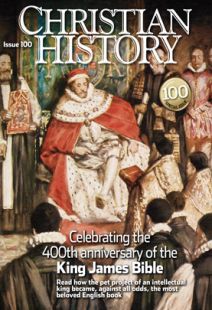Pre-KJV English translations
SO FAR AS ANYONE KNOWS, the Bible first touched English soil near the end of the 6th century A.D. when a missionary, St. Augustine, carried one across the Channel. Of course, this was not an English version, but the Latin Vulgate of St. Jerome. For centuries, it would be virtually the only written Bible in Britain. How, then, did ordinary folk—mostly illiterate—obtain their biblical knowledge? Essentially, from a variety of oral and visual sources. Preachers delivering sermons would preface their homilies with paraphrases of relevant texts. Artwork on church windows and walls might depict the expulsion of Adam and Eve from the Garden or Jesus’ temptation in the wilderness. Later, the mystery play helped communicate the stories of Abraham and Isaac, Noah, the Christmas shepherds, and, indeed, the entire cycle of biblical narrative from Genesis to Revelation.
To be sure, from the 7th century on, a series of Anglo-Saxon versions of parts of the Bible emerged. Credit for the first usually goes to Caedmon, whose “Hymn” (ca. 670) paraphrased the Genesis creation story in verse form. Around 700, Aldhelm translated the Psalms, and several years later Bede himself may have translated at least the Gospel of John (ca. 735), though his work has not survived. In the 9th century, King Alfred rendered portions of Exodus, Psalms, and Acts into Old English. From the 10th century on, there appeared a series of Anglo-Saxon gospels, including the famous Lindisfarne Gospels (actually an earlier Latin MS with an interlinear Anglo-Saxon translation added).
Credit for the first complete English translation of the Bible goes to John Wyclif, who rendered the Vulgate into Middle English in the 14th century. Two versions of the Wyclif Bible appeared between 1380 and 1397, of which around 180 manuscripts survive.
The development of the Gutenberg Press (1455), its introduction into England by Caxton (1475), and the onset of the Protestant Reformation paved the way for the flurry of new translations that appeared in the 16th century. The first was the work of William Tyndale, whose New Testament (c. 1525) was the first part of the Bible printed in the English language. Tyndale was the first to go beyond the Vulgate to a Greek text for his New Testament, and a Hebrew text for the portion of the Old Testament he completed. Unfortunately, his work stirred up such English concern over possible “heresy” that it had to be published in Germany. Tyndale himself was burned at the stake in 1536.
The first complete Bible printed in English was the work of Miles Coverdale (1535). It was based on the Vulgate, Tyndale, and Luther’s German translation. Two years later, it in turn became a source for Matthew’s Bible (1537)—actually a combination of Tyndale and Coverdale by John Rogers (who used the pseudonym “Thomas Matthew”). The Great Bible appeared in 1539—requested by Henry VIII.
For the next product of this prolific century we turn to Geneva, Switzerland. There a group of English Puritans sought refuge from the persecutions of their Catholic monarch, Mary Tudor. And there they produced one of the most influential translations of all times: the Geneva Bible (1560) (for more on the Geneva Bible, as well as the pre-KJV Roman Catholic Douay-Rheims Bible, see “No overnight success,” p. 22).
This Puritan version represented such a threat to mainline English Protestantism that the Anglican Church soon autho- rized its own revision of the Great Bible. The resulting Bishops’ Bible (1568) became the official version in England. CH
By David Lyle Jeffrey
[Christian History originally published this article in Christian History Issue #100 in 2011]
Adapted by permission from David Lyle Jeffrey, “The English Bible: A Brief History of Translation,” in A Dictionary of Biblical Tradition in English Literature. Grand Rapids, MI: Eerdmans, 1992.Next articles
The shorter Lord’s Prayer [Luke11:2–4] in early English versions
How the Lord’s Prayer sounded in early English Bibles (Luke’s version)
David Lyle JeffreyNo overnight success
Fans of the KJV like to think their favorite Bible burst onto the scene in 1611 with all the fanfare such a masterpiece deserved. Here’s the real story
A. Kenneth CurtisAmerican Jews and the KJV
Some Jews objected to the KJV’s Christian interpretation of Old Testament passages
Ann T. Snyderold book in a new world
The colonies started fresh in a lot of areas, but Bible translation wasn’t one of them; overwhelmingly, the KJV has been the U.S. Bible of choice
Chris R. ArmstrongSupport us
Christian History Institute (CHI) is a non-profit Pennsylvania corporation founded in 1982. Your donations support the continuation of this ministry
Donate



